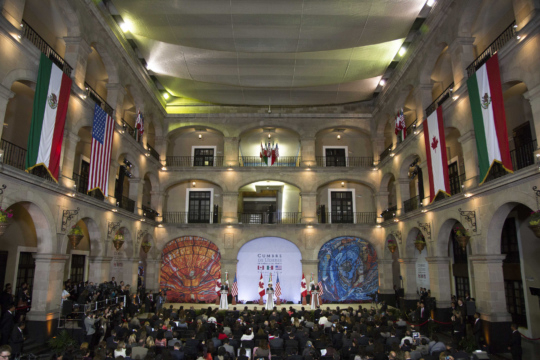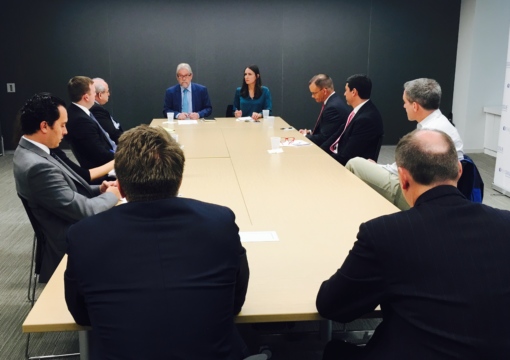
Beyond Contributory Pensions
Pension reforms in Latin America have shifted between an emphasis on coverage, adequacy, and sustainability.
A Daily Publication of The Dialogue
Mexico’s government and the country’s private sector have ironed out the details of a pension reform that is expected to take effect early next year. Under the plan, the average worker’s pension will rise 40 percent, Finance Minister Arturo Herrera said. Is the new plan likely to be approved in Mexico’s Congress? Where is the increased payout coming from? How will the proposal affect workers and the country’s current pension funds, known as the Afores?
Gerónimo Gutiérrez Fernández, senior advisor at Covington and former Mexican ambassador to the United States: “The possibility of a pension reform has raised many questions given Mexico’s current political and economic environment. In July, however, the government, private sector and key labor unions announced a consensus on core elements of a bill to be discussed in Congress the rest of the year. Details still need to be fleshed out, but three positive aspects can be highlighted. The reform builds upon the individual account defined-contribution system created in 1997, rather than return to a state-managed defined-benefit system. This is a plus for property rights, fiscal sustainability and overall financial stability, especially in order to avoid an Argentina-type scenario. Yes, the bulk of the reform is paid by gradually raising employer contributions from 5.15 percent to 13.875 percent, but the private sector is on board. Government and business seem to have reached a middle-ground solution, which could serve as reference for other policies. Finally, the reform will benefit about 20 million Mexicans—especially those with lower incomes—with better pensions. We can still expect ample debate, but there is a good chance the reform will move through Congress before the year’s end. The president supports it, and his party has ample congressional majorities. The main criticism comes from those who think that, given Mexico’s large informal sector, the scope of reform could fall short. Yet, pension fund administrators and other financial institutions are working on voluntary saving schemes that help address this concern. These and other issues seem to call for fine tuning rather than cancellation of a much-needed reform.”
Tapen Sinha, professor of risk management at the Instituto Tecnológico Autónomo de México and professor at the University of Nottingham Business School: “Right now, with Morena ruling the roost, it would be an easy exercise for the current government to pass the new plan. Nobody in the government has talked about the extra costs. The employers will be required to increase their contribution from 5.151 percent to 13.875 percent in eight years. That will add to the cost of doing business for the private formal sector. They will react by reducing employment in the formal sector by hiring people either through ‘honorarios’ or by hiring more in the informal sector. The result will be a reduction of formal full-term employment in the private sector. There will also be additional costs by reducing the vesting period from 25 to 15 years. The cost for the ‘top up’ to 13.875 percent for people with less than four times the Measurement and Evaluation Unit, or UMA, inflation indexing benchmark, will be borne by the government. Given the employment conditions today, I estimate that cost will amount to between 0.3 percent and 0.4 percent of GDP per year. The extra requirement for the Afores to reduce the fees is a welcome change in the right direction that should have been done a long time ago. It will increase the final value of the Afore for the workers by at least 5 percent. The big question is: Where will that extra money be invested? Will the Afores be allowed to freely invest in what they see fit or will they be forced to invest the extra inflow to government-directed infrastructure? If the government requires the latter, then we will see a rise in investment in white-elephant projects such as the Tren Maya or the oil refineries in Tabasco. That will be a disaster for the workers in the long run. They will have lower final payouts in their retirement funds.”
Leslie Palma, senior counsel, and Juan Pablo Moyano, associate, at Holland & Knight in Mexico City: “President López Obrador’s pension reform proposal is pending approval in Mexico’s Congress, but it is very likely that lawmakers will approve it, given that the president has an overwhelming majority in Congress. Broadly speaking, this proposal greatly benefits employees. Employees previously had to work in formal jobs for 25 years in order to receive a pension through this system, but the time they would have to work under the reform will be shortened to 15 years. Retirees’ pensions are comprised of contributions by employers, employees and the government. López Obrador’s proposal will modify employer contributions, which will be gradually increased from 5.15 percent to 13.7 percent over a period of six years. Additionally, the reform seeks to gradually reduce the commissions charged by the retirement fund administrators, or Afores, down to 1 percent. Also, through federal contributions, the country’s lowest-paid workers will see significant increases under the proposed reform. Finally, the percentage of workers entitled to a pension will increase from 57 percent to 97 percent, and 82 percent of the population will have access to a pension, up from 34 percent. Therefore, in the future, more employees will receive higher pensions.”
Alma Caballero, director at McLarty Associates: “The reform, which will affect more than 20 million Mexicans, is expected to be approved by the Mexican Congress by early 2021 as it enjoys ample support from political parties, trade unions and business associations. This historic reform marks a big step for the AMLO administration in finding common ground with the business community, congressional leaders and the labor sector. The proposed reform will increase the level of compulsory contributions to 15 percent of salaries from 6.5 percent over eight years, bringing rates closer to international standards and having the extra burden shouldered by employers. The plan reforms the investment regime and guarantees pensions to workers who meet the requirement of 750 weeks worked (approximately 15 years) as opposed to the current system in which Mexicans need to work at least 1,250 weeks (approximately 25 years) to be eligible for a pension. Even though this reform seeks to address the low pensions that workers in the formal sector receive, it falls short of addressing the informality rate in Mexico, which rose to 51.8 percent in May. Additionally, nearly 50 percent of young Mexicans (ages 15–29) do not save, and more than 80 percent of the 62.9 million workers with an Afore didn’t voluntarily contribute to their account in 2018. Mexicans still lack a ‘savings culture’ through formal alternatives where one has to be willing to forgo current short-term desires for unexpected future expenses and/or external financial shocks, such as the economic crisis resulting from the Covid-19 pandemic, during which close to 1.2 million formal jobs have been lost in Mexico.”
 The Latin America Advisor features Q&A from leaders in politics, economics, and finance every business day. It is available to members of the Dialogue’s Corporate Program and others by subscription.
The Latin America Advisor features Q&A from leaders in politics, economics, and finance every business day. It is available to members of the Dialogue’s Corporate Program and others by subscription.
Pension reforms in Latin America have shifted between an emphasis on coverage, adequacy, and sustainability.
Mexico’s energy reform has led to a remarkable boost in investment, and the expected increase in the country’s crude oil production will strengthen energy security not only for Mexico but also at the regional level.
In spite of a steady economic recovery, low inflation and improving fiscal balances, Latin America is seeing weak private investment in energy and other sectors.
 Mexican Finance Minister Arturo Herrera said a proposed reform will increase the average worker’s pension. // File Photo: Mexican Government.
Mexican Finance Minister Arturo Herrera said a proposed reform will increase the average worker’s pension. // File Photo: Mexican Government.

